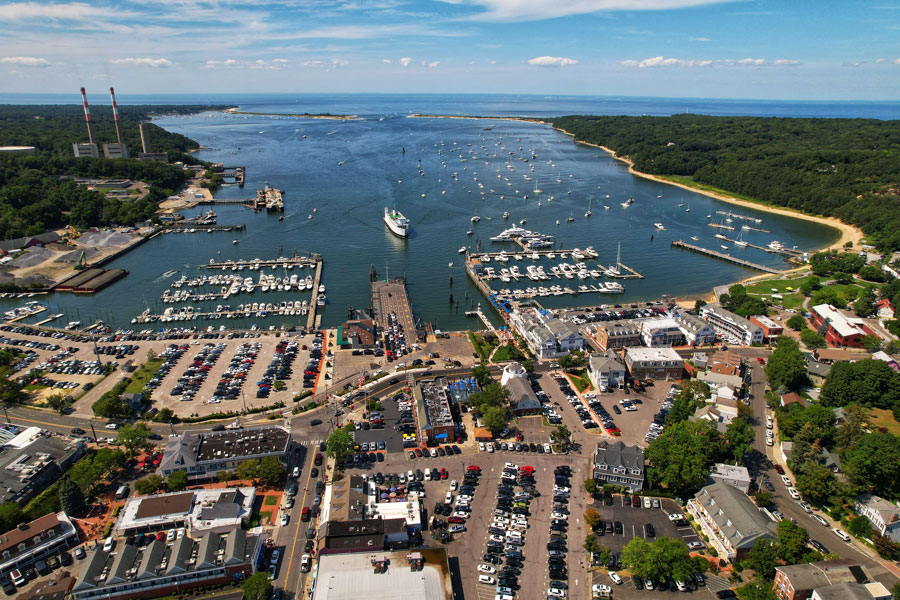Port Jefferson, New York

Port Jefferson (“Port Jeff”) is an incorporated village in the Town of Brookhaven on Long Island’s North Shore, about 50–60 miles east of Manhattan. With a scenic deep-water harbor, it serves as the cultural, commercial, and transit hub of the surrounding region.
History & Maritime Heritage
- First settled in the 17th century, it was originally known as Sowaysset or Drowned Meadow due to tidal marshes.
- In 1836, Captain William L. Jones built a causeway across the salt marsh, laying the foundation for today’s downtown Main Street. The village was renamed in honor of President Jefferson.
- By the mid-1800s, Port Jefferson became a major shipbuilding center, with firms constructing whaling vessels and freighters; remnants of this era include the preserved Mather House Museum and the historic Bayles Shipyard, both part of its heritage.
- Tourism replaced shipbuilding in the 20th century, though the Bridgeport & Port Jefferson Ferry, in operation since 1883, continues to link the village with Connecticut.
Population & Demographics
- 2020 population: ~7,962; 2023 estimate: ~8,029
- Median age: ~45
- Median household income: ~$143k (2023)
- Homeownership rate: ~71%
- Ethnicity: ~79% White, ~7% Asian, ~10% Hispanic, 16% foreign-born.
Transportation & Connectivity
- Ferry terminal: The Bridgeport–Port Jefferson route runs across Long Island Sound in ~1h15m, handling over 1.15 million passengers in 2023 .
- LIRR terminus: Port Jefferson is the end of the Port Jefferson Branch, serving commuters from across Brookhaven.
- Road access: Well-connected via state and local roads; walkable “Upper” (near train station) and “Lower” (near harbor) districts.
Downtown & Economy
- Two retail cores: waterfront “Lower Port” and transit-centric “Upper Port” are linked by charming Main Street.
- Economy now centers on tourism, hospitality, retail, and dining, building on its shipbuilding past.
- Low unemployment and high school quality; local schools maintain ~10:1 student-teacher ratio .
Attractions & Recreation
- Mather House Museum: Offers deep dive into the village’s shipbuilding heritage.
- Bayles Shipyard & Harborfront Park: Repurposed industrial waterfront includes village center and public park.
- Port Jefferson Harbor: Active with marinas, sightseeing, and waterfront restaurants; ferries and boats are frequent sights.
- Historic district: 98 buildings spanning Greek Revival to Italianate styles (built 1800–1915), listed on the National Register in 2005.
- Annual events: Dickens Festival (December) and the Village Cup Regatta; the latter supports cancer research.
Infrastructure & Services
- Port Jefferson Power Station: A major generating facility built 1948–1960; still active and subject to modernization plans.
- Public amenities: Includes the highly regarded Port Jefferson Library (est. 1909, >165K holdings), parks, boater services, and over 300 hospital beds in the metro area.
Village Snapshot
| Feature | Details |
|---|---|
| Population | ~8,000; median age ~45 |
| Income | ~$143k median household income |
| Housing | ~71% homeownership; median property ~$628k |
| Transit | Ferry to CT, LIRR terminus, walkable downtowns |
| Economy | Tourism, retail, dining, maritime services |
| Heritage | Shipbuilding legacy, Mather House, Bayles Yard |
| Culture | Historic district, Dickens Fest, regattas |
| Recreation | Harborfront Park, marinas, waterfront dining |
| Power | Significant 498 MW power plant on harbor edge |
| Library | 1909 branch with major community circulation |

